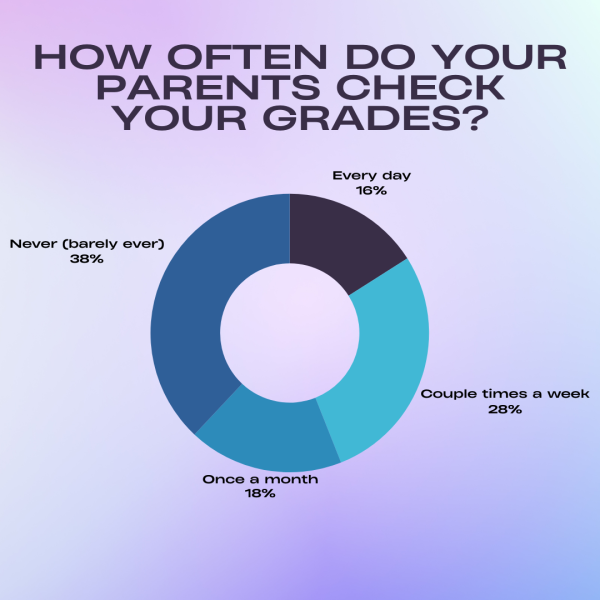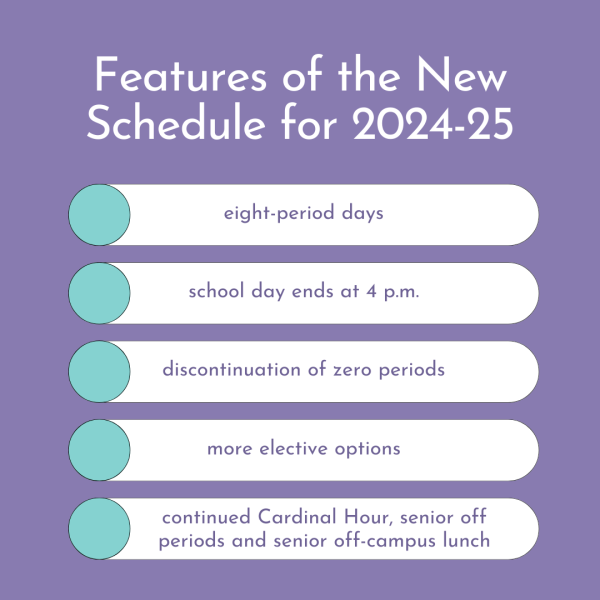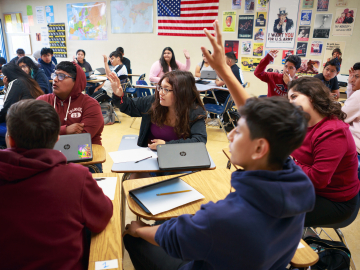- March 18 Eight a day
- March 14 ‘Upping our game’
- March 9 Senior Joshua Percy wins Mr. Bellaire
- March 5 Falling short in the postseason
- February 29 Cardinals continue magical playoff run


Three Penny Press

Students spend three times longer on homework than average, survey reveals
Sonya Kulkarni and Pallavi Gorantla | Jan 9, 2022

Graphic by Sonya Kulkarni
The National Education Association and the National Parent Teacher Association have suggested that a healthy number of hours that students should be spending can be determined by the “10-minute rule.” This means that each grade level should have a maximum homework time incrementing by 10 minutes depending on their grade level (for instance, ninth-graders would have 90 minutes of homework, 10th-graders should have 100 minutes, and so on).
As ‘finals week’ rapidly approaches, students not only devote effort to attaining their desired exam scores but make a last attempt to keep or change the grade they have for semester one by making up homework assignments.
High schoolers reported doing an average of 2.7 hours of homework per weeknight, according to a study by the Washington Post from 2018 to 2020 of over 50,000 individuals. A survey of approximately 200 Bellaire High School students revealed that some students spend over three times this number.
The demographics of this survey included 34 freshmen, 43 sophomores, 54 juniors and 54 seniors on average.
When asked how many hours students spent on homework in a day on average, answers ranged from zero to more than nine with an average of about four hours. In contrast, polled students said that about one hour of homework would constitute a healthy number of hours.
Junior Claire Zhang said she feels academically pressured in her AP schedule, but not necessarily by the classes.
“The class environment in AP classes can feel pressuring because everyone is always working hard and it makes it difficult to keep up sometimes.” Zhang said.
A total of 93 students reported that the minimum grade they would be satisfied with receiving in a class would be an A. This was followed by 81 students, who responded that a B would be the minimum acceptable grade. 19 students responded with a C and four responded with a D.
“I am happy with the classes I take, but sometimes it can be very stressful to try to keep up,” freshman Allyson Nguyen said. “I feel academically pressured to keep an A in my classes.”
Up to 152 students said that grades are extremely important to them, while 32 said they generally are more apathetic about their academic performance.
Last year, nine valedictorians graduated from Bellaire. They each achieved a grade point average of 5.0. HISD has never seen this amount of valedictorians in one school, and as of now there are 14 valedictorians.
“I feel that it does degrade the title of valedictorian because as long as a student knows how to plan their schedule accordingly and make good grades in the classes, then anyone can be valedictorian,” Zhang said.
Bellaire offers classes like physical education and health in the summer. These summer classes allow students to skip the 4.0 class and not put it on their transcript. Some electives also have a 5.0 grade point average like debate.
Close to 200 students were polled about Bellaire having multiple valedictorians. They primarily answered that they were in favor of Bellaire having multiple valedictorians, which has recently attracted significant acclaim .
Senior Katherine Chen is one of the 14 valedictorians graduating this year and said that she views the class of 2022 as having an extraordinary amount of extremely hardworking individuals.
“I think it was expected since freshman year since most of us knew about the others and were just focused on doing our personal best,” Chen said.
Chen said that each valedictorian achieved the honor on their own and deserves it.
“I’m honestly very happy for the other valedictorians and happy that Bellaire is such a good school,” Chen said. “I don’t feel any less special with 13 other valedictorians.”
Nguyen said that having multiple valedictorians shows just how competitive the school is.
“It’s impressive, yet scary to think about competing against my classmates,” Nguyen said.
Offering 30 AP classes and boasting a significant number of merit-based scholars Bellaire can be considered a competitive school.
“I feel academically challenged but not pressured,” Chen said. “Every class I take helps push me beyond my comfort zone but is not too much to handle.”
Students have the opportunity to have off-periods if they’ve met all their credits and are able to maintain a high level of academic performance. But for freshmen like Nguyen, off periods are considered a privilege. Nguyen said she usually has an hour to five hours worth of work everyday.
“Depending on the day, there can be a lot of work, especially with extra curriculars,” Nguyen said. “Although, I am a freshman, so I feel like it’s not as bad in comparison to higher grades.”
According to the survey of Bellaire students, when asked to evaluate their agreement with the statement “students who get better grades tend to be smarter overall than students who get worse grades,” responders largely disagreed.
Zhang said that for students on the cusp of applying to college, it can sometimes be hard to ignore the mental pressure to attain good grades.
“As a junior, it’s really easy to get extremely anxious about your GPA,” Zhang said. “It’s also a very common but toxic practice to determine your self-worth through your grades but I think that we just need to remember that our mental health should also come first. Sometimes, it’s just not the right day for everyone and one test doesn’t determine our smartness.”

Parental influence

HUMANS OF BELLAIRE – Andy Shen

‘Running since day one’

Finding sparks in concerts

HUMANS OF BELLAIRE – Zachary Foust

Eight a day

‘Upping our game’

Senior Joshua Percy wins Mr. Bellaire

Falling short in the postseason

Cardinals continue magical playoff run
Humans of Bellaire

HUMANS OF BELLAIRE – Veda Manikonda
![average time to complete homework Junior Quinn Shefman snorkels along the coast of Portugal. She said what she saw under the water changed [her] perspective on the world.](https://threepennypress.org/wp-content/uploads/2024/03/IMG_4219-600x450.jpg)
‘All of these beautiful things’

HUMANS OF BELLAIRE – Renee Lasprilla

Soaring toward her dreams

Leading with faith
The student news site of Bellaire High School
- Letter to the Editor
- Submit a Story Idea
- Advertising/Sponsorships
Comments (7)
Cancel reply
Your email address will not be published. Required fields are marked *
Anonymous • Nov 21, 2023 at 10:32 am
It’s not really helping me understand how much.
josh • May 9, 2023 at 9:58 am
Kassie • May 6, 2022 at 12:29 pm
Im using this for an English report. This is great because on of my sources needed to be from another student. Homework drives me insane. Im glad this is very updated too!!
Kaylee Swaim • Jan 25, 2023 at 9:21 pm
I am also using this for an English report. I have to do an argumentative essay about banning homework in schools and this helps sooo much!
Izzy McAvaney • Mar 15, 2023 at 6:43 pm
I am ALSO using this for an English report on cutting down school days, homework drives me insane!!
E. Elliott • Apr 25, 2022 at 6:42 pm
I’m from Louisiana and am actually using this for an English Essay thanks for the information it was very informative.
Nabila Wilson • Jan 10, 2022 at 6:56 pm
Interesting with the polls! I didn’t realize about 14 valedictorians, that’s crazy.
11 Surprising Homework Statistics, Facts & Data

The age-old question of whether homework is good or bad for students is unanswerable because there are so many “ it depends ” factors.
For example, it depends on the age of the child, the type of homework being assigned, and even the child’s needs.
There are also many conflicting reports on whether homework is good or bad. This is a topic that largely relies on data interpretation for the researcher to come to their conclusions.
To cut through some of the fog, below I’ve outlined some great homework statistics that can help us understand the effects of homework on children.
Homework Statistics List
1. 45% of parents think homework is too easy for their children.
A study by the Center for American Progress found that parents are almost twice as likely to believe their children’s homework is too easy than to disagree with that statement.
Here are the figures for math homework:
- 46% of parents think their child’s math homework is too easy.
- 25% of parents think their child’s math homework is not too easy.
- 29% of parents offered no opinion.
Here are the figures for language arts homework:
- 44% of parents think their child’s language arts homework is too easy.
- 28% of parents think their child’s language arts homework is not too easy.
- 28% of parents offered no opinion.
These findings are based on online surveys of 372 parents of school-aged children conducted in 2018.
2. 93% of Fourth Grade Children Worldwide are Assigned Homework
The prestigious worldwide math assessment Trends in International Maths and Science Study (TIMSS) took a survey of worldwide homework trends in 2007. Their study concluded that 93% of fourth-grade children are regularly assigned homework, while just 7% never or rarely have homework assigned.
3. 17% of Teens Regularly Miss Homework due to Lack of High-Speed Internet Access
A 2018 Pew Research poll of 743 US teens found that 17%, or almost 2 in every 5 students, regularly struggled to complete homework because they didn’t have reliable access to the internet.
This figure rose to 25% of Black American teens and 24% of teens whose families have an income of less than $30,000 per year.
4. Parents Spend 6.7 Hours Per Week on their Children’s Homework
A 2018 study of 27,500 parents around the world found that the average amount of time parents spend on homework with their child is 6.7 hours per week. Furthermore, 25% of parents spend more than 7 hours per week on their child’s homework.
American parents spend slightly below average at 6.2 hours per week, while Indian parents spend 12 hours per week and Japanese parents spend 2.6 hours per week.
5. Students in High-Performing High Schools Spend on Average 3.1 Hours per night Doing Homework
A study by Galloway, Conner & Pope (2013) conducted a sample of 4,317 students from 10 high-performing high schools in upper-middle-class California.
Across these high-performing schools, students self-reported that they did 3.1 hours per night of homework.
Graduates from those schools also ended up going on to college 93% of the time.
6. One to Two Hours is the Optimal Duration for Homework
A 2012 peer-reviewed study in the High School Journal found that students who conducted between one and two hours achieved higher results in tests than any other group.
However, the authors were quick to highlight that this “t is an oversimplification of a much more complex problem.” I’m inclined to agree. The greater variable is likely the quality of the homework than time spent on it.
Nevertheless, one result was unequivocal: that some homework is better than none at all : “students who complete any amount of homework earn higher test scores than their peers who do not complete homework.”
7. 74% of Teens cite Homework as a Source of Stress
A study by the Better Sleep Council found that homework is a source of stress for 74% of students. Only school grades, at 75%, rated higher in the study.
That figure rises for girls, with 80% of girls citing homework as a source of stress.
Similarly, the study by Galloway, Conner & Pope (2013) found that 56% of students cite homework as a “primary stressor” in their lives.
8. US Teens Spend more than 15 Hours per Week on Homework
The same study by the Better Sleep Council also found that US teens spend over 2 hours per school night on homework, and overall this added up to over 15 hours per week.
Surprisingly, 4% of US teens say they do more than 6 hours of homework per night. That’s almost as much homework as there are hours in the school day.
The only activity that teens self-reported as doing more than homework was engaging in electronics, which included using phones, playing video games, and watching TV.
9. The 10-Minute Rule
The National Education Association (USA) endorses the concept of doing 10 minutes of homework per night per grade.
For example, if you are in 3rd grade, you should do 30 minutes of homework per night. If you are in 4th grade, you should do 40 minutes of homework per night.
However, this ‘rule’ appears not to be based in sound research. Nevertheless, it is true that homework benefits (no matter the quality of the homework) will likely wane after 2 hours (120 minutes) per night, which would be the NEA guidelines’ peak in grade 12.
10. 21.9% of Parents are Too Busy for their Children’s Homework
An online poll of nearly 300 parents found that 21.9% are too busy to review their children’s homework. On top of this, 31.6% of parents do not look at their children’s homework because their children do not want their help. For these parents, their children’s unwillingness to accept their support is a key source of frustration.
11. 46.5% of Parents find Homework too Hard
The same online poll of parents of children from grades 1 to 12 also found that many parents struggle to help their children with homework because parents find it confusing themselves. Unfortunately, the study did not ask the age of the students so more data is required here to get a full picture of the issue.
Get a Pdf of this article for class
Enjoy subscriber-only access to this article’s pdf
Interpreting the Data
Unfortunately, homework is one of those topics that can be interpreted by different people pursuing differing agendas. All studies of homework have a wide range of variables, such as:
- What age were the children in the study?
- What was the homework they were assigned?
- What tools were available to them?
- What were the cultural attitudes to homework and how did they impact the study?
- Is the study replicable?
The more questions we ask about the data, the more we realize that it’s hard to come to firm conclusions about the pros and cons of homework .
Furthermore, questions about the opportunity cost of homework remain. Even if homework is good for children’s test scores, is it worthwhile if the children consequently do less exercise or experience more stress?
Thus, this ends up becoming a largely qualitative exercise. If parents and teachers zoom in on an individual child’s needs, they’ll be able to more effectively understand how much homework a child needs as well as the type of homework they should be assigned.
Related: Funny Homework Excuses
The debate over whether homework should be banned will not be resolved with these homework statistics. But, these facts and figures can help you to pursue a position in a school debate on the topic – and with that, I hope your debate goes well and you develop some great debating skills!

Chris Drew (PhD)
Dr. Chris Drew is the founder of the Helpful Professor. He holds a PhD in education and has published over 20 articles in scholarly journals. He is the former editor of the Journal of Learning Development in Higher Education. [Image Descriptor: Photo of Chris]
- Chris Drew (PhD) https://helpfulprofessor.com/author/chris-drew-phd/ 5 Top Tips for Succeeding at University
- Chris Drew (PhD) https://helpfulprofessor.com/author/chris-drew-phd/ 50 Durable Goods Examples
- Chris Drew (PhD) https://helpfulprofessor.com/author/chris-drew-phd/ 100 Consumer Goods Examples
- Chris Drew (PhD) https://helpfulprofessor.com/author/chris-drew-phd/ 30 Globalization Pros and Cons
Leave a Comment Cancel Reply
Your email address will not be published. Required fields are marked *
Analyzing ‘the homework gap’ among high school students
Subscribe to the brown center on education policy newsletter, michael hansen and michael hansen senior fellow - brown center on education policy , the herman and george r. brown chair - governance studies @drmikehansen diana quintero diana quintero former senior research analyst, brown center on education policy - the brookings institution, ph.d. student - vanderbilt university @quintero05diana.
August 10, 2017
Researchers have struggled for decades to identify a causal, or even correlational, relationship between time spent in school and improved learning outcomes for students. Some studies have focused on the length of a school year while others have focused on hours in a day and others on hours in the week .
In this blog post, we will look at time spent outside of school–specifically time spent doing homework–among different racial and socio-economic groups. We will use data from the American Time Use Survey (ATUS) to shed light on those differences and then attempt to explain those gaps, using ATUS data and other evidence.
What we know about out-of-school time
Measuring the relationship between out-of-school time and outcomes like test scores can be difficult. Researchers are primarily confounded by an inability to determine what compels students to choose homework during their time off over other activities. Are those who spend more time on homework just extra motivated? Or are they struggling students who need to work harder to keep up? What role do social expectations from parents or peers play?
Previous studies have examined the impact of this outside time use on educational outcomes for students. A 2007 study using data from Berea College in Kentucky identified a causal relationship between hours spent studying and a student’s academic performance through an interesting measure. The researchers took advantage of randomly assigned college roommates, paying attention to those who came to campus with a video game console in tow. They hypothesized students randomly assigned to a roommate without a video game console would study more, since all other factors remained equal. That hypothesis held up, and that group also received significantly higher grades, demonstrating the causal relationship.
Other research has relied on data collected through the American Time Use Survey, a study of how Americans spend their time, and shown the existence of a gender gap and a parental education gap in homework time. Other studies have looked at the relationship between holding a job and student’s time use in discretionary activities , like sleep, media consumption, and time spent on homework. We are curious about out-of-school differences in homework time by race and income.

Descriptive statistics of time use
We began with a general sample of 2,575 full-time high school students between the ages of 15 and 18 from the ATUS, restricting the sample to their answers about time spent on homework during weekdays and school months (September to May). Among all high school students surveyed (those that reported completing their homework and those that did not), the time allocated to complete homework amounted to less than an hour per day, despite the fact that high school teachers report they assign an average of 3.5 hours of homework per day.
To explore racial or income-based differences, in Figure 1, we plot the minutes that students reporting spending on homework separately by their racial/ethnic group and family income. We observed a time gap between racial groups, with Asian students spending the most time on homework (nearly two hours a day). Similarly, we observe a time gap by the students’ family income.

We can also use ATUS data to isolate when students do homework by race and by income. In Figure 2, we plot the percentage of high school students in each racial and income group doing homework by the time of day. Percentages remain low during the school day and then expectedly increase when students get home, with more Asian students doing more homework and working later into the night than other racial groups. Low-income students reported doing less homework per hour than their non-low-income peers.

Initial attempts to explain the homework gap
We hypothesized that these racial and income-based time gaps could potentially be explained by other factors, like work, time spent caring for others, and parental education. We tested these hypotheses by separating groups based on particular characteristics and comparing the average number of minutes per day spent on homework amongst the comparison groups.
Students who work predictably reported spending less time on educational activities, so if working disproportionately affected particular racial or income groups, then work could help explain the time gap. Students who worked allocated on average 20 minutes less for homework than their counterparts who did not work. Though low-income students worked more hours than their peers, they largely maintained a similar level of homework time by reducing their leisure or extracurricular activities. Therefore, the time gap on homework changed only slightly with the inclusion of work as a factor.
We also incorporated time spent taking care of others in the household. Though a greater percentage of low-income students take care of other household members, we found that this does not have a statistically significant effect on homework because students reduce leisure, rather than homework, in an attempt to help their families. Therefore, this variable again does not explain the time gaps.
Finally, we considered parental education, since parents with more education have been shown to encourage their children to value school more and have the resources to ensure homework is completed more easily. Our analysis showed students with at least one parent with any post-secondary degree (associate or above) reported spending more time on homework than their counterparts whose parents do not hold a degree; however, gaps by race still existed, even holding parental education constant. Turning to income levels, we found that parental education is more correlated with homework time among low-income students, reducing the time gap between income groups to only eight minutes.
Societal explanations
Our analysis of ATUS could not fully explain this gap in time spent on homework, especially among racial groups. Instead, we believe that viewing homework as an outcome of the culture of the school and the expectations of teachers, rather than an outcome of a student’s effort, may provide some reasons for its persistence.
Many studies, including recent research , have shown that teachers perceive students of color as academically inferior to their white peers. A 2016 study by Seth Gershenson et al. showed that this expectations gap can also depend on the race of the teacher. In a country where minority students make up nearly half of all public school students, yet minority teachers comprise just 18 percent of the teacher workforce, these differences in expectations matter.
Students of color are also less likely to attend high schools that offer advanced courses (including Advanced Placement courses) that would likely assign more homework, and thus access to rigorous courses may partially explain the gaps as well.
Research shows a similar, if less well-documented, gap by income, with teachers reporting lower expectations and dimmer futures for their low-income students. Low-income students and students of color may be assigned less homework based on lower expectations for their success, thus preventing them from learning as much and creating a self-fulfilling prophecy .
In conclusion, these analyses of time use revealed a substantial gap in homework by race and by income group that could not be entirely explained by work, taking care of others, or parental education. Additionally, differences in educational achievement, especially as measured on standardized tests, have been well-documented by race and by income . These gaps deserve our attention, but we should be wary of blaming disadvantaged groups. Time use is an outcome reflecting multiple factors, not simply motivation, and a greater understanding of that should help raise expectations–and therefore, educational achievement–all around.
Sarah Novicoff contributed to this post.
Related Content
Michael Hansen, Diana Quintero
October 5, 2016
Sarah Novicoff, Matthew A. Kraft
November 15, 2022
September 10, 2015
K-12 Education
Governance Studies
Brown Center on Education Policy
Darcy Hutchins, Emily Markovich Morris, Laura Nora, Carolina Campos, Adelaida Gómez Vergara, Nancy G. Gordon, Esmeralda Macana, Karen Robertson
March 28, 2024
Jennifer B. Ayscue, Kfir Mordechay, David Mickey-Pabello
March 26, 2024
Anna Saavedra, Morgan Polikoff, Dan Silver
- Our Mission

What’s the Right Amount of Homework?
Decades of research show that homework has some benefits, especially for students in middle and high school—but there are risks to assigning too much.
Many teachers and parents believe that homework helps students build study skills and review concepts learned in class. Others see homework as disruptive and unnecessary, leading to burnout and turning kids off to school. Decades of research show that the issue is more nuanced and complex than most people think: Homework is beneficial, but only to a degree. Students in high school gain the most, while younger kids benefit much less.
The National PTA and the National Education Association support the “ 10-minute homework guideline ”—a nightly 10 minutes of homework per grade level. But many teachers and parents are quick to point out that what matters is the quality of the homework assigned and how well it meets students’ needs, not the amount of time spent on it.
The guideline doesn’t account for students who may need to spend more—or less—time on assignments. In class, teachers can make adjustments to support struggling students, but at home, an assignment that takes one student 30 minutes to complete may take another twice as much time—often for reasons beyond their control. And homework can widen the achievement gap, putting students from low-income households and students with learning disabilities at a disadvantage.
However, the 10-minute guideline is useful in setting a limit: When kids spend too much time on homework, there are real consequences to consider.
Small Benefits for Elementary Students
As young children begin school, the focus should be on cultivating a love of learning, and assigning too much homework can undermine that goal. And young students often don’t have the study skills to benefit fully from homework, so it may be a poor use of time (Cooper, 1989 ; Cooper et al., 2006 ; Marzano & Pickering, 2007 ). A more effective activity may be nightly reading, especially if parents are involved. The benefits of reading are clear: If students aren’t proficient readers by the end of third grade, they’re less likely to succeed academically and graduate from high school (Fiester, 2013 ).
For second-grade teacher Jacqueline Fiorentino, the minor benefits of homework did not outweigh the potential drawback of turning young children against school at an early age, so she experimented with dropping mandatory homework. “Something surprising happened: They started doing more work at home,” Fiorentino writes . “This inspiring group of 8-year-olds used their newfound free time to explore subjects and topics of interest to them.” She encouraged her students to read at home and offered optional homework to extend classroom lessons and help them review material.
Moderate Benefits for Middle School Students
As students mature and develop the study skills necessary to delve deeply into a topic—and to retain what they learn—they also benefit more from homework. Nightly assignments can help prepare them for scholarly work, and research shows that homework can have moderate benefits for middle school students (Cooper et al., 2006 ). Recent research also shows that online math homework, which can be designed to adapt to students’ levels of understanding, can significantly boost test scores (Roschelle et al., 2016 ).
There are risks to assigning too much, however: A 2015 study found that when middle school students were assigned more than 90 to 100 minutes of daily homework, their math and science test scores began to decline (Fernández-Alonso, Suárez-Álvarez, & Muñiz, 2015 ). Crossing that upper limit can drain student motivation and focus. The researchers recommend that “homework should present a certain level of challenge or difficulty, without being so challenging that it discourages effort.” Teachers should avoid low-effort, repetitive assignments, and assign homework “with the aim of instilling work habits and promoting autonomous, self-directed learning.”
In other words, it’s the quality of homework that matters, not the quantity. Brian Sztabnik, a veteran middle and high school English teacher, suggests that teachers take a step back and ask themselves these five questions :
- How long will it take to complete?
- Have all learners been considered?
- Will an assignment encourage future success?
- Will an assignment place material in a context the classroom cannot?
- Does an assignment offer support when a teacher is not there?
More Benefits for High School Students, but Risks as Well
By the time they reach high school, students should be well on their way to becoming independent learners, so homework does provide a boost to learning at this age, as long as it isn’t overwhelming (Cooper et al., 2006 ; Marzano & Pickering, 2007 ). When students spend too much time on homework—more than two hours each night—it takes up valuable time to rest and spend time with family and friends. A 2013 study found that high school students can experience serious mental and physical health problems, from higher stress levels to sleep deprivation, when assigned too much homework (Galloway, Conner, & Pope, 2013 ).
Homework in high school should always relate to the lesson and be doable without any assistance, and feedback should be clear and explicit.
Teachers should also keep in mind that not all students have equal opportunities to finish their homework at home, so incomplete homework may not be a true reflection of their learning—it may be more a result of issues they face outside of school. They may be hindered by issues such as lack of a quiet space at home, resources such as a computer or broadband connectivity, or parental support (OECD, 2014 ). In such cases, giving low homework scores may be unfair.
Since the quantities of time discussed here are totals, teachers in middle and high school should be aware of how much homework other teachers are assigning. It may seem reasonable to assign 30 minutes of daily homework, but across six subjects, that’s three hours—far above a reasonable amount even for a high school senior. Psychologist Maurice Elias sees this as a common mistake: Individual teachers create homework policies that in aggregate can overwhelm students. He suggests that teachers work together to develop a school-wide homework policy and make it a key topic of back-to-school night and the first parent-teacher conferences of the school year.
Parents Play a Key Role
Homework can be a powerful tool to help parents become more involved in their child’s learning (Walker et al., 2004 ). It can provide insights into a child’s strengths and interests, and can also encourage conversations about a child’s life at school. If a parent has positive attitudes toward homework, their children are more likely to share those same values, promoting academic success.
But it’s also possible for parents to be overbearing, putting too much emphasis on test scores or grades, which can be disruptive for children (Madjar, Shklar, & Moshe, 2015 ). Parents should avoid being overly intrusive or controlling—students report feeling less motivated to learn when they don’t have enough space and autonomy to do their homework (Orkin, May, & Wolf, 2017 ; Patall, Cooper, & Robinson, 2008 ; Silinskas & Kikas, 2017 ). So while homework can encourage parents to be more involved with their kids, it’s important to not make it a source of conflict.
- Future Students
- Current Students
- Faculty/Staff

News and Media
- News & Media Home
- Research Stories
- School's In
- In the Media
You are here
More than two hours of homework may be counterproductive, research suggests.

A Stanford education researcher found that too much homework can negatively affect kids, especially their lives away from school, where family, friends and activities matter. "Our findings on the effects of homework challenge the traditional assumption that homework is inherently good," wrote Denise Pope , a senior lecturer at the Stanford Graduate School of Education and a co-author of a study published in the Journal of Experimental Education . The researchers used survey data to examine perceptions about homework, student well-being and behavioral engagement in a sample of 4,317 students from 10 high-performing high schools in upper-middle-class California communities. Along with the survey data, Pope and her colleagues used open-ended answers to explore the students' views on homework. Median household income exceeded $90,000 in these communities, and 93 percent of the students went on to college, either two-year or four-year. Students in these schools average about 3.1 hours of homework each night. "The findings address how current homework practices in privileged, high-performing schools sustain students' advantage in competitive climates yet hinder learning, full engagement and well-being," Pope wrote. Pope and her colleagues found that too much homework can diminish its effectiveness and even be counterproductive. They cite prior research indicating that homework benefits plateau at about two hours per night, and that 90 minutes to two and a half hours is optimal for high school. Their study found that too much homework is associated with: • Greater stress : 56 percent of the students considered homework a primary source of stress, according to the survey data. Forty-three percent viewed tests as a primary stressor, while 33 percent put the pressure to get good grades in that category. Less than 1 percent of the students said homework was not a stressor. • Reductions in health : In their open-ended answers, many students said their homework load led to sleep deprivation and other health problems. The researchers asked students whether they experienced health issues such as headaches, exhaustion, sleep deprivation, weight loss and stomach problems. • Less time for friends, family and extracurricular pursuits : Both the survey data and student responses indicate that spending too much time on homework meant that students were "not meeting their developmental needs or cultivating other critical life skills," according to the researchers. Students were more likely to drop activities, not see friends or family, and not pursue hobbies they enjoy. A balancing act The results offer empirical evidence that many students struggle to find balance between homework, extracurricular activities and social time, the researchers said. Many students felt forced or obligated to choose homework over developing other talents or skills. Also, there was no relationship between the time spent on homework and how much the student enjoyed it. The research quoted students as saying they often do homework they see as "pointless" or "mindless" in order to keep their grades up. "This kind of busy work, by its very nature, discourages learning and instead promotes doing homework simply to get points," said Pope, who is also a co-founder of Challenge Success , a nonprofit organization affiliated with the GSE that conducts research and works with schools and parents to improve students' educational experiences.. Pope said the research calls into question the value of assigning large amounts of homework in high-performing schools. Homework should not be simply assigned as a routine practice, she said. "Rather, any homework assigned should have a purpose and benefit, and it should be designed to cultivate learning and development," wrote Pope. High-performing paradox In places where students attend high-performing schools, too much homework can reduce their time to foster skills in the area of personal responsibility, the researchers concluded. "Young people are spending more time alone," they wrote, "which means less time for family and fewer opportunities to engage in their communities." Student perspectives The researchers say that while their open-ended or "self-reporting" methodology to gauge student concerns about homework may have limitations – some might regard it as an opportunity for "typical adolescent complaining" – it was important to learn firsthand what the students believe. The paper was co-authored by Mollie Galloway from Lewis and Clark College and Jerusha Conner from Villanova University.
Clifton B. Parker is a writer at the Stanford News Service .
More Stories

⟵ Go to all Research Stories
Get the Educator
Subscribe to our monthly newsletter.
Stanford Graduate School of Education
482 Galvez Mall Stanford, CA 94305-3096 Tel: (650) 723-2109
Improving lives through learning
- Contact Admissions
- GSE Leadership
- Site Feedback
- Web Accessibility
- Career Resources
- Faculty Open Positions
- Explore Courses
- Academic Calendar
- Office of the Registrar
- Cubberley Library
- StanfordWho
- StanfordYou

- Stanford Home
- Maps & Directions
- Search Stanford
- Emergency Info
- Terms of Use
- Non-Discrimination
- Accessibility
© Stanford University , Stanford , California 94305 .

How Much Time Do College Students Spend on Homework
by Jack Tai | Oct 9, 2019 | Articles
Does college life involve more studying or socializing?
Find out how much time college students need to devote to their homework in order to succeed in class.
We all know that it takes hard work to succeed in college and earn top grades.
To find out more about the time demands of studying and learning, let’s review the average homework amounts of college students.
HowtoLearn.com expert, Jack Tai, CEO of OneClass.com shows how homework improves grades in college and an average of how much time is required.
How Many Hours Do College Students Spend on Homework?
Classes in college are much different from those in high school.
For students in high school, a large part of learning occurs in the classroom with homework used to support class activities.
One of the first thing that college students need to learn is how to read and remember more quickly. It gives them a competitive benefit in their grades and when they learn new information to escalate their career.
Taking a speed reading course that shows you how to learn at the same time is one of the best ways for students to complete their reading assignments and their homework.

However, in college, students spend a shorter period in class and spend more time learning outside of the classroom.
This shift to an independent learning structure means that college students should expect to spend more time on homework than they did during high school.
In college, a good rule of thumb for homework estimates that for each college credit you take, you’ll spend one hour in the classroom and two to three hours on homework each week.
These homework tasks can include readings, working on assignments, or studying for exams.
Based upon these estimates, a three-credit college class would require each week to include approximately three hours attending lectures and six to nine hours of homework.
Extrapolating this out to the 15-credit course load of a full-time student, that would be 15 hours in the classroom and 30 to 45 hours studying and doing homework.
These time estimates demonstrate that college students have significantly more homework than the 10 hours per week average among high school students. In fact, doing homework in college can take as much time as a full-time job.
Students should keep in mind that these homework amounts are averages.
Students will find that some professors assign more or less homework. Students may also find that some classes assign very little homework in the beginning of the semester, but increase later on in preparation for exams or when a major project is due.
There can even be variation based upon the major with some areas of study requiring more lab work or reading.
Do College Students Do Homework on Weekends?
Based on the quantity of homework in college, it’s nearly certain that students will be spending some of their weekends doing homework.
For example, if each weekday, a student spends three hours in class and spends five hours on homework, there’s still at least five hours of homework to do on the weekend.

When considering how homework schedules can affect learning, it’s important to remember that even though college students face a significant amount of homework, one of the best learning strategies is to space out study sessions into short time blocks.
This includes not just doing homework every day of the week, but also establishing short study blocks in the morning, afternoon, and evening. With this approach, students can avoid cramming on Sunday night to be ready for class.
What’s the Best Way to Get Help with Your Homework?
In college, there are academic resources built into campus life to support learning.
For example, you may have access to an on-campus learning center or tutoring facilities. You may also have the support of teaching assistants or regular office hours.
That’s why OneClass recommends a course like How to Read a Book in a Day and Remember It which gives a c hoice to support your learning.
Another choice is on demand tutoring.
They send detailed, step-by-step solutions within just 24 hours, and frequently, answers are sent in less than 12 hours.
When students have on-demand access to homework help, it’s possible to avoid the poor grades that can result from unfinished homework.
Plus, 24/7 Homework Help makes it easy to ask a question. Simply snap a photo and upload it to the platform.
That’s all tutors need to get started preparing your solution.
Rather than retyping questions or struggling with math formulas, asking questions and getting answers is as easy as click and go.
Homework Help supports coursework for both high school and college students across a wide range of subjects. Moreover, students can access OneClass’ knowledge base of previously answered homework questions.
Simply browse by subject or search the directory to find out if another student struggled to learn the same class material.
Related articles
NEW COURSE: How to Read a Book in a Day and Remember It

Call for Entries Parent and Teacher Choice Awards. Winners Featured to Over 2 Million People

All About Reading-Comprehensive Instructional Reading Program

Parent & Teacher Choice Award Winner – Letter Tracing for Kids

Parent and Teacher Choice Award Winner – Number Tracing for Kids ages 3-5

Parent and Teacher Choice Award winner! Cursive Handwriting for Kids

One Minute Gratitude Journal

Parent and Teacher Choice Award winner! Cursive Handwriting for Teens

Make Teaching Easier! 1000+ Images, Stories & Activities

Prodigy Math and English – FREE Math and English Skills

Recent Posts
- 5 Essential Techniques to Teach Sight Words to Children
- 7 Most Common Reading Problems and How to Fix Them
- Best Program for Struggling Readers
- 21 Interactive Reading Strategies for Pre-Kindergarten
- 27 Education Storybook Activities to Improve Literacy
Recent Comments
- Glenda on How to Teach Spelling Using Phonics
- Dorothy on How to Tell If You Are an Employee or Entrepreneur
- Pat Wyman on 5 Best Focus and Motivation Tips
- kapenda chibanga on 5 Best Focus and Motivation Tips
- Jennifer Dean on 9 Proven Ways to Learn Anything Faster
How Much Homework Do American Kids Do?
Various factors, from the race of the student to the number of years a teacher has been in the classroom, affect a child's homework load.
![average time to complete homework [IMAGE DESCRIPTION]](https://cdn.theatlantic.com/assets/media/img/posts/Ryan_Homework_Post.jpg)
In his Atlantic essay , Karl Taro Greenfeld laments his 13-year-old daughter's heavy homework load. As an eighth grader at a New York middle school, Greenfeld’s daughter averaged about three hours of homework per night and adopted mantras like “memorization, not rationalization” to help her get it all done. Tales of the homework-burdened American student have become common, but are these stories the exception or the rule?
A 2007 Metlife study found that 45 percent of students in grades three to 12 spend more than an hour a night doing homework, including the six percent of students who report spending more than three hours a night on their homework. In the 2002-2003 school year, a study out of the University of Michigan found that American students ages six through 17 spent three hours and 38 minutes per week doing homework.
A range of factors plays into how much homework each individual student gets:
Older students do more homework than their younger counterparts.
This one is fairly obvious: The National Education Association recommends that homework time increase by ten minutes per year in school. (e.g., A third grader would have 30 minutes of homework, while a seventh grader would have 70 minutes).
Studies have found that schools tend to roughly follow these guidelines: The University of Michigan found that students ages six to eight spend 29 minutes doing homework per night while 15- to 17-year-old students spend 50 minutes doing homework. The Metlife study also found that 50 percent of students in grades seven to 12 spent more than an hour a night on homework, while 37 percent of students in grades three to six spent an hour or more on their homework per night. The National Center for Educational Statistics found that high school students who do homework outside of school average 6.8 hours of homework per week.
![average time to complete homework [IMAGE DESCRIPTION]](https://cdn.theatlantic.com/assets/media/img/posts/Ryan_Homework_MetlifeGraph.jpg)
Race plays a role in how much homework students do.
Asian students spend 3.5 more hours on average doing homework per week than their white peers. However, only 59 percent of Asian students’ parents check that homework is done, while 75.6 percent of Hispanic students’ parents and 83.1 percent of black students’ parents check.
![average time to complete homework [IMAGE DESCRIPTION]](https://cdn.theatlantic.com/assets/media/img/posts/Ryan_Homework_NCESGraph.jpg)
Teachers with less experience assign more homework.
The Metlife study found that 14 percent of teachers with zero to five years of teaching experience assigned more than an hour of homework per night, while only six percent of teachers with 21 or more years of teaching experience assigned over an hour of homework.
![average time to complete homework [IMAGE DESCRIPTION]](https://cdn.theatlantic.com/assets/media/img/posts/Ryan_Homework_GraphTeachers.jpg)
Math classes have homework the most frequently.
The Metlife study found that 70 percent of students in grades three to 12 had at least one homework assignment in math. Sixty-two percent had at least one homework assignment in a language arts class (English, reading, spelling, or creative writing courses) and 42 percent had at least one in a science class.
Regardless of how much homework kids are actually doing every night, most parents and teachers are happy with the way things are: 60 percent of parents think that their children have the “right amount of homework,” and 73 percent of teachers think their school assigns the right amount of homework.
Students, however, are not necessarily on board: 38 percent of students in grades seven through 12 and 28 percent of students in grades three through six report being “very often/often” stressed out by their homework.

IMAGES
VIDEO
COMMENTS
High schoolers reported doing an average of 2.7 hours of homework per weeknight, according to a study by the Washington Post from 2018 to 2020 of over 50,000 individuals. A survey of approximately 200 Bellaire High School students revealed that some students spend over three times this number. The demographics of this survey included 34 ...
A 2018 Pew Research poll of 743 US teens found that 17%, or almost 2 in every 5 students, regularly struggled to complete homework because they didn’t have reliable access to the internet. This figure rose to 25% of Black American teens and 24% of teens whose families have an income of less than $30,000 per year. 4.
Among all high school students surveyed (those that reported completing their homework and those that did not), the time allocated to complete homework amounted to less than an hour per day ...
The National PTA and the National Education Association support the “ 10-minute homework guideline ”—a nightly 10 minutes of homework per grade level. But many teachers and parents are quick to point out that what matters is the quality of the homework assigned and how well it meets students’ needs, not the amount of time spent on it.
In places where students attend high-performing schools, too much homework can reduce their time to foster skills in the area of personal responsibility, the researchers concluded. "Young people are spending more time alone," they wrote, "which means less time for family and fewer opportunities to engage in their communities." Student perspectives
NOTE: Data are based on the responses of the parent most knowledgeable about the student's education. Data exclude students who did not do homework outside of school; in 2007, parents reported that about 7 percent of 9th- through 12th-grade students did not do homework outside of school. Total includes other racial/ethnic groups not separately ...
Extrapolating this out to the 15-credit course load of a full-time student, that would be 15 hours in the classroom and 30 to 45 hours studying and doing homework. These time estimates demonstrate that college students have significantly more homework than the 10 hours per week average among high school students.
Table 227.40. Percentage of elementary and secondary school students who do homework, average time spent doing homework, percentage whose parents check that homework is done, and percentage whose parents help with homework, by frequency and selected characteristics: 2007, 2012, 2016, and 2019
Too much homework may diminish its effectiveness. While research on the optimum amount of time students should spend on homework is limited, there are indications that for high school students, 1½ to 2½ hours per night is optimum. Middle school students appear to benefit from smaller amounts (less than 1 hour per night).
A 2007 Metlife study found that 45 percent of students in grades three to 12 spend more than an hour a night doing homework, including the six percent of students who report spending more than ...